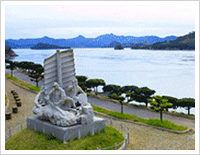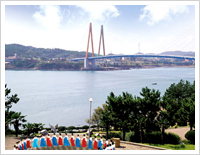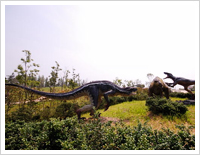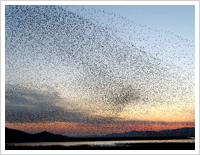Myeongryang Great Victory Site of Woosooyoung - A Breath of Patriotism
Woosoo tourist attraction that commemorates Myeongryang great victory achieved by Choongmoogong in 1597 and embraces an image of old holy place was designated as national tourist site in 1986 and as its first project, memorial park of Myeongryang great victory was created at the place overlooking Wooldolmok in 1990. In remains exhibition hall of Choongmoogong, Cheonjachongtong and Jijachongtong that were used during Myeongryang naval battle were exhibited and a video showing great activities at that time is displayed as well. In addition, vivid impression is delivered by deploying sculptures showing an image of battle of voluntary soldiers and government soldiers at the time of Japanese invasion in Imjin Year at every corner of the park.

Myeongryang Great Victory Park
Myeongryang Great Victory ParkMyeongryang great victory site is a place where General Lee, Soon-shin with his 13 turtle ships achieved a decisive moment of finishing 7 years of Japanese invasion in Imjin Year by destroying 133 battle ships of Japanese invaders who were moving northward to the Yellow Sea by using terrain and current of Myeongryang. In Wooldolmok that was the last bridgehead of Japanese invasion in Imjin Year, a cruise ship in a shape of turtle ship is being operated.

Myeongryang Great Victory Monument
On Myeongryang great victory monument, history of Myeongryang great victory achieved in Wooldolmok on March 16, Jeongyoo Year (1597) by Choongmoogong during King Sookjong of Choseon Era is recorded and portrait of General Lee enshrined in Choongmoosa was painted by painter, Eeedang Lee, Eun-ho in 1966 by reviving dignity of General Lee.

Wooldolmok
Wooldolmok that is also named as Myeongryang which means crying sea is the narrowest strait connecting Woosooyoung of Haenam-gun with Nokjin of Jindo-gun and as its width is 325m, the deepest water depth 20m, flow velocity 11.5knots, rapidly whirling current is flowing between reefs with severe bends.
It is said that the sea sound of this rapid current colliding with reefs is heard from a place distanced by app. 8km. This topographic features became a cause of crushing defeat to invading 400 Japanese warships before anything could be done. Now over the sea of Wooldolmok that bursted into tears, just Jindo grand bridge crosses the blank sky quietly.

Woohangri Dinosaur Museum
In the coastal area of Woohangri, Hwangsan-myeon, fossil group of palaeobios unique in the world that is presumed to be the fossil of bird footprint, tree trunk fossil and dinosaur footprint aged app. 90million years are located. Footprint fossil of bird with webbed feet makes the academic circle surprised as it was revealed to be Cretaceous formation that is ahead of Cenozoic Era formation of Eose region of the USA that was known for the first time in the world by app. 40million years. In addition, at every corner of coastal line, sunken dinosaur footprint track in the size of bowl could be found.
Webb feet fossil over 1,000 spots are clearly printed on the surface of rocks with width of 0.5-1m and length of app. 15m under the cliff of sedimentary rock and these spots could be found together with surrounding pterosaur footprint.

Wintering Site of Migratory Birds in Gocheonam
Wintering Site of Migratory Birds in Gocheonam In reed field of Gocheonam, reeds are widely growing along the side (14km) of Gocheonam lake and reed field area of 3km extended from Boohori of Haenam0eub to Yeongokri of Hwasan-myeon is 500,000 pyeong which is the largest domestic reed habitat. In addition, in this reed field of Gocheonam, baikal teals accounting for 98% of the world baikal teals as well as rare birds such as black stork and eagle are showing fantastic group dancing during wintering season.






 Korean
Korean Chinese
Chinese Japanese
Japanese











